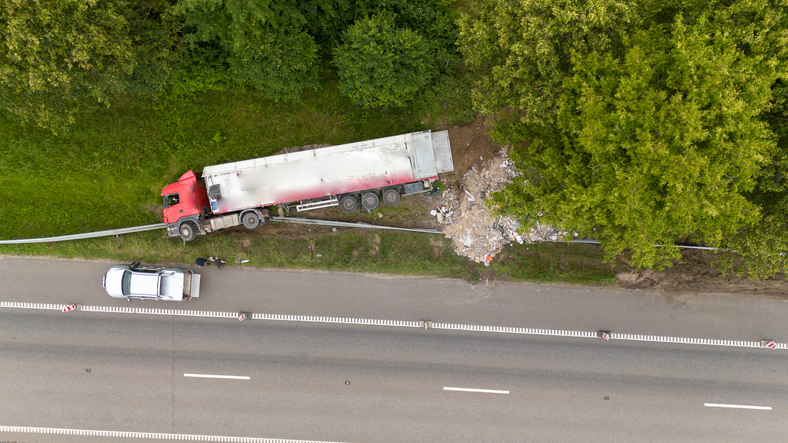We’ve all been there—cruising down I-35 when a massive 18-wheeler looms in your rearview mirror or begins merging into your lane. For many drivers, large trucks are intimidating, but few truly understand the challenges these vehicles (and their operators) face on the road every day.
The reality is that a lack of awareness about how semi-trucks operate leads to countless avoidable accidents each year. If more drivers understood the physics, limitations, and responsibilities of big rigs, our highways would be far safer places.
Here are five things most drivers don’t realize about sharing the road with commercial trucks—and why knowing them could save your life.
1. They Have Massive Blind Spots (And You’re Probably in One)
You’ve likely seen the warning stickers on the back of trucks: “If you can’t see my mirrors, I can’t see you.” That’s not just a clever slogan—it’s a serious safety warning.
According to the Federal Motor Carrier Safety Administration (FMCSA), large trucks have four major blind spots, or “no-zones”:
-
Directly in front of the cab
-
Directly behind the trailer
-
On the driver’s side, from the cab to the middle of the trailer
-
On the passenger side, which can span two or more lanes
If you’re riding alongside a truck in these zones, especially during lane changes or turns, the driver may not know you’re there—until it’s too late.
2. They Can’t Stop Like You Can
A fully loaded tractor-trailer traveling at 65 mph requires up to 525 feet to come to a complete stop, depending on road conditions and weight. That’s roughly the length of two football fields.
Compare that to the 316 feet needed by an average passenger vehicle, and it’s easy to see the danger in cutting off a truck or braking suddenly in front of one.
This braking disparity is one of the top contributors to rear-end collisions involving big rigs. The National Highway Traffic Safety Administration (NHTSA) recommends maintaining a minimum of 4 to 5 seconds of following distance behind a semi-truck—and never cutting directly in front of one.
3. They Make Wide Turns—and Need the Space
Ever seen a truck swing into the left lane just to make a right turn? That’s not careless driving—it’s basic geometry.
Large trucks need extra turning room, especially at intersections. They may have to initiate a turn from a center lane or swing wide to avoid running over curbs, signs, or pedestrians. Impatient drivers often try to sneak around them, which can lead to side-impact collisions or being crushed between the trailer and the curb.
According to the Texas Department of Insurance, one of the most common fatal errors drivers make is trying to pass a truck on the right while it’s turning.
4. They’re Often Carrying Dangerous or Heavy Loads
Many trucks are transporting hazardous materials, flammable cargo, or unbalanced freight—all of which increase the risk and severity of a crash. Improperly secured cargo can shift during transit, leading to rollovers, jackknifing, or lost loads spilling into traffic.
Truck drivers and their companies are legally obligated to follow cargo safety standards laid out by the FMCSA. However, not every load is inspected, and violations still occur.
As a passenger vehicle driver, it’s wise to avoid driving too close behind or beside these trucks, especially on curves, ramps, or downhill slopes.
5. Driver Fatigue Is a Serious Issue in the Trucking Industry
Despite regulations limiting how long commercial drivers can stay on the road, driver fatigue remains a major issue. The FMCSA estimates that 13% of truck crashes involve fatigued drivers, and the problem may be underreported.
Long-haul truckers often drive hundreds of miles a day, and even small lapses in concentration can result in catastrophic consequences.
As a fellow driver, assume the truck driver might not be operating at 100%, especially late at night or early in the morning. Maintain extra space and don’t assume quick reaction times.
Drive Defensively—Not Aggressively
The best way to avoid a serious truck-related accident? Drive like your life depends on it—because it does. Defensive driving means:
-
Avoiding blind spots
-
Never tailgating large trucks
-
Giving trucks room to turn or change lanes
-
Not trying to “beat” them through merges or lights
Texas highways, especially in growing cities like Austin, are increasingly congested with commercial traffic. Understanding the realities of how trucks move, stop, and operate can help you avoid becoming a tragic statistic.
If a Truck Accident Happens, Know Your Rights
Unfortunately, even careful drivers can fall victim to the negligence of trucking companies or their drivers. If you or a loved one has been injured in a truck-related crash—whether due to driver fatigue, poor maintenance, or reckless operation—you may be entitled to compensation.
Speaking with an experienced Austin trucking accident attorney can help you protect your rights and pursue accountability from the responsible parties. Contact a truck accident attorney today. Trucking companies have legal teams on their side—you should too.
Big rigs may rule the highway, but safety still lies in how we choose to drive around them. Stay informed. Stay alert. Stay alive.

